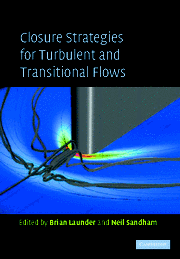10 - Reacting Flows and Probability Density Function Methods
Published online by Cambridge University Press: 06 July 2010
Summary
Introduction
In this chapter the statistical description of turbulent reacting flow is considered. In particular second moment closure for variable density flows and the one-point probability density function (PDF) approach are introduced.
In turbulence modelling a subset of statistical properties is obtained by calculating a selected set of moments (e.g. mean and variances of quantities at one point in space) from modelled transport equations. For reacting flow it is advantageous to enlarge the subset to involve the complete probability density function of variables defined at one point in space and time. This approach leads to an incomplete description of turbulence properties and closure assumptions have to be made.
The structure of the presentation in this chapter is as follows: instantaneous conservation equations are considered first because they provide the basis for the averaged equations and also for the transport equation satisfied by the probability density function. Next some basic concepts from statistics are considered. Finally the mean conservation equations are introduced and a discussion of the main closure problems and their possible solution in terms of second moment equations and/or PDFs are given. A more detailed description of models and results is given in [20] and [21]. Further information on the PDF approach can be found in Pope (1985), Dopazo (1994), Fox (1996), Pope (2000).
Instantaneous conservation equations
Conservation of mass is expressed by the continuity equation, and conservation of momentum (here in the absence of external forces) by the Navier–Stokes equation, in which p is pressure and Tij the viscous stress tensor. For a Newtonian fluid the viscous stress tensor contains only simple shear effects and can be written as in which μ is the dynamic viscosity.
The conservation equations for species mass fractions, denoted here by the scalar vector ϕ, read where Jαj is the diffusion flux and Sα is a chemical reaction source term. Neglecting effects of thermal diffusion and external body forces and assuming Fickian diffusion, the flux reads in which ID is the mass diffusion coefficient which here for simplicity is assumed to be equal for all species. The enthalpy conservation equation which in general is also needed, is also of the form (4) with the enthalpy source term in particular containing effects of radiative heat transfer. The description is completed with the thermodynamic equation of state and the caloric equation of state (relating enthalpy and composition to temperature).
- Type
- Chapter
- Information
- Closure Strategies for Turbulent and Transitional Flows , pp. 328 - 338Publisher: Cambridge University PressPrint publication year: 2002



